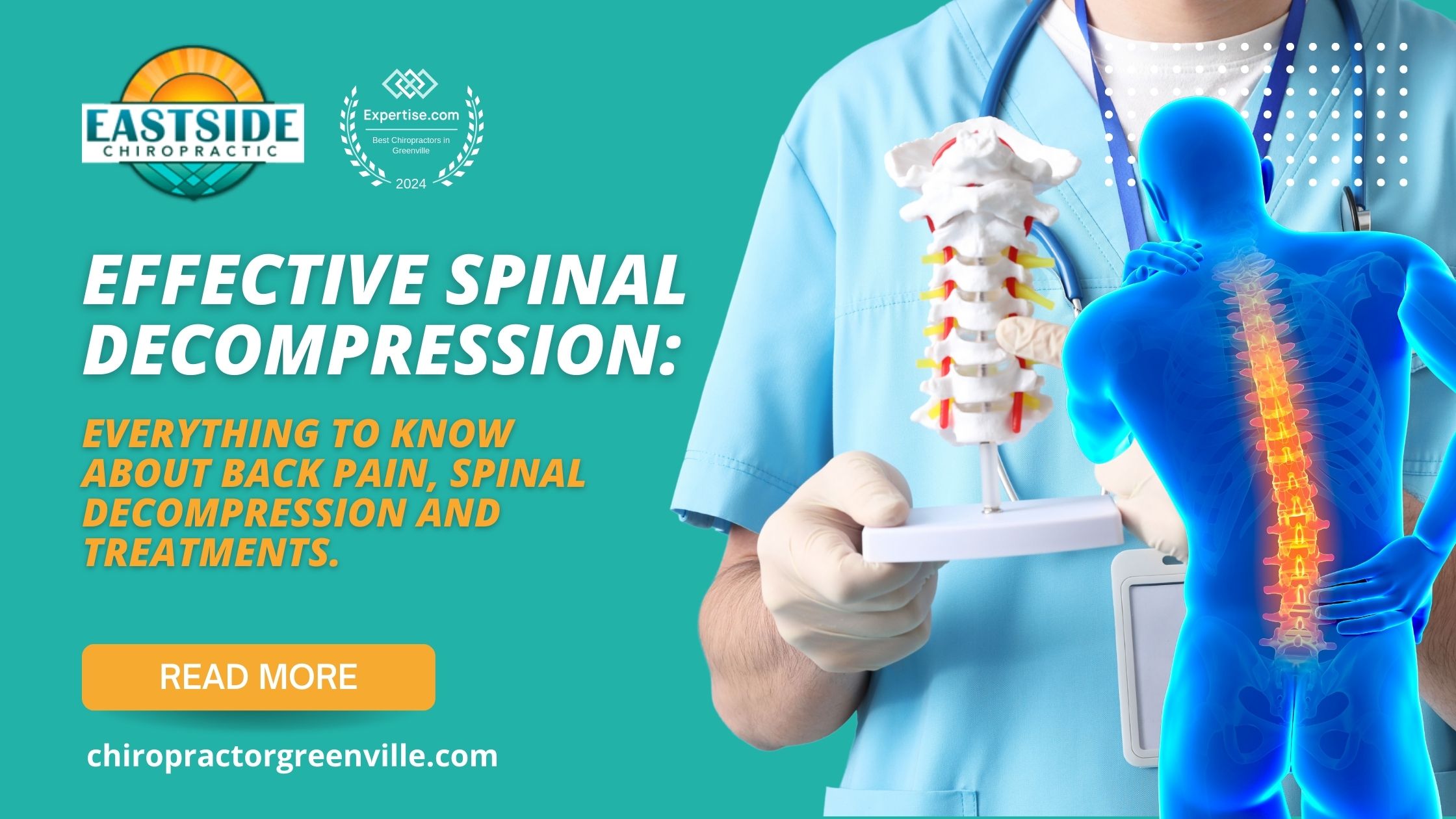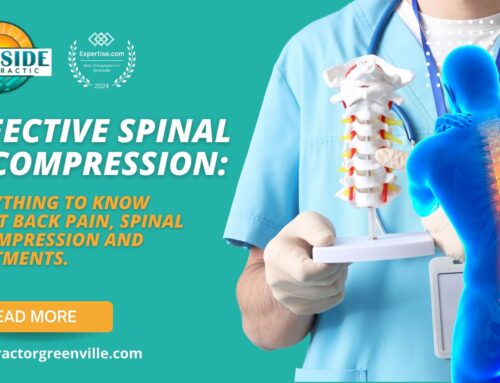Introduction
Hello, Greenville! If you’ve been feeling that nagging back pain for what seems like forever, it’s time to talk about something you may have never considered before—spinal decompression therapy. Whether you’re dealing with a herniated disc or persistent sciatica, spinal decompression could be the answer to your woes. Let’s dive into why this could be a game-changer for your spine health.
What is Spinal Decompression Therapy?
So, what exactly is spinal decompression therapy? Think of it like a gentle stretch for your spine. It’s a non-invasive treatment that relieves pressure on the spinal discs and nerves. Through a series of carefully controlled movements, spinal decompression aims to improve your spine health and alleviate pain.
Types of Spinal Decompression
Surgical Decompression
Surgical decompression is the invasive route, involving procedures like laminectomy or discectomy to relieve pressure on the spinal nerves. While effective, surgery comes with its own set of risks and a longer recovery time.
Non-Surgical Decompression
Non-surgical spinal decompression, on the other hand, uses a motorized traction device to stretch the spine gently. This process creates a negative pressure within the disc, allowing for better nutrient flow and encouraging disc healing.
Why Choose Non-Surgical Spinal Decompression?
Benefits
Why go under the knife when you don’t have to? Non-surgical spinal decompression offers a painless, drug-free solution with no downtime. Patients often experience rapid relief from pain and a noticeable improvement in mobility.
Safety
Compared to surgical options, non-surgical decompression therapy is much safer with minimal risk of complications. It’s a gentle and controlled treatment under the supervision of experienced professionals.
Conditions Treated by Spinal Decompression Therapy
Herniated Discs
Herniated discs can cause excruciating pain and numbness that radiates down your limbs. Spinal decompression helps by reducing the pressure on these discs, promoting retraction and healing.
Degenerative Disc Disease
As we age, our spinal discs can wear down, leading to chronic pain. Decompression therapy can help to rehydrate the discs and reduce the symptoms of degenerative disc disease.
Sciatica
Got that shooting pain down your leg? Yup, that’s sciatica. Decompression therapy can relieve the pressure on the sciatic nerve, easing the pain.
Spinal Stenosis
A narrowing spinal canal can pinch nerves and cause considerable discomfort. Decompression therapy can help to widen the canal and relieve the symptoms.
How Spinal Decompression Therapy Works
The Procedure
Imagine lying comfortably on a specialized table while a machine applies a controlled stretch to your spine. Sessions typically last about 30 to 45 minutes. Over multiple sessions, this process helps reduce disc pressure and improve spine health.
Technology Involved
Advanced technology ensures that the traction applied is precise and customized to each patient’s needs. The whole system is designed to optimize the healing environment inside the affected discs.
Why Opt for Spinal Decompression at Eastside Chiropractic PA?
Expertise and Experience
At Eastside Chiropractic PA, you’re in the hands of skilled professionals with years of experience in spinal health. Our team is well-versed in the latest techniques and technologies in spinal decompression therapy.
Personalized Care
We believe in a personalized approach. Each treatment plan is tailored to address your specific condition and needs, ensuring the best possible outcome.
Success Stories and Testimonials
Patient Testimonials
Our patients’ stories speak volumes. Stories of getting back to their favorite activities, playing with their kids again, and most importantly, living pain-free. We couldn’t be prouder of the transformations we’ve witnessed.
Case Studies
From chronic herniated discs to severe sciatica, our case studies show consistent success in using spinal decompression therapy to alleviate pain and improve spinal health.
What to Expect During Spinal Decompression Therapy?
Initial Consultation
Your journey begins with a detailed consultation, where we dig deep into your medical history and perform a thorough examination. We want to understand your unique condition and lifestyle to create a tailored treatment plan.
Treatment Sessions
Each session is usually comfortable and relaxing. You will lie down on a motorized table, and the machine will do its magic. Sessions are scheduled a few times a week for several weeks, depending on your condition.
Risks and Considerations
Potential Side Effects
Like any medical treatment, spinal decompression therapy comes with some risks, but they are minimal. You might experience slight muscle aches or spasms, but these typically resolve quickly.
Who Should Avoid This Therapy?
While it’s a fantastic option for many, spinal decompression therapy is not suitable for everyone. Pregnant women, individuals with severe osteoporosis, or those with certain cancers should avoid this treatment.
Complementary Treatments
Physical Therapy
Pairing decompression therapy with physical therapy can offer better results. Strengthening the muscles around your spine can help maintain the benefits of decompression therapy longer.
Chiropractic Adjustments
Chiropractic care complements spinal decompression beautifully. Regular adjustments can help to keep your spine aligned and functional.
Frequently Asked Questions
Is spinal decompression therapy painful?
No, it’s generally a comfortable experience. Some patients even find it relaxing as it relieves their pain.
How many sessions will I need?
The number of sessions varies based on your specific condition. Typically, patients see improvement within 6-8 weeks.
Is spinal decompression covered by insurance?
Many insurance plans do cover spinal decompression therapy, but it’s best to check with your provider.
Can I go back to work immediately after the sessions?
Yes, there is no downtime required. You can typically go back to your daily activities right after each session.
How effective is spinal decompression therapy?
While results can vary, many patients experience significant relief from pain and improved mobility.
Spinal Decompression Therapy vs. Other Treatments
Comparison with Physical Therapy
While physical therapy focuses on strengthening and flexibility, spinal decompression specifically targets disc issues, making the two treatments complementary rather than competitive.
Comparison with Surgery
Surgery is often seen as a last resort due to its invasive nature and longer recovery time. Spinal decompression offers a non-invasive alternative with quicker results and fewer risks.
How to Prepare for Your First Visit
What to Bring
Bring any relevant medical records, a list of current medications, and a positive attitude. We’re here to help you get better.
Questions to Ask
Don’t hesitate to ask about the treatment plan, the technology involved, potential side effects, and what kind of results you can expect.
Conclusion
Spinal decompression therapy at Eastside Chiropractic PA in Greenville, SC is more than just a treatment; it’s a pathway to reclaiming your quality of life. With a skilled team, personalized care plans, and state-of-the-art technology, we are committed to helping you say goodbye to back pain and hello to a healthier, more active you. Ready to take the first step? Contact us today to schedule your consultation and start your journey towards a pain-free life.
FAQs
1. How long does a spinal decompression therapy session last?
A typical session lasts between 30 to 45 minutes.
2. Is spinal decompression therapy suitable for all ages?
While it can benefit many age groups, it’s essential to have a thorough consultation to determine if it’s right for you.
3. What should I wear to my spinal decompression sessions?
Wear comfortable, loose-fitting clothing to ensure you are at ease during the treatment.
4. Can spinal decompression therapy cure my back pain permanently?
While it can provide significant relief and promote healing, ongoing care and lifestyle changes may be needed to maintain results.
5. Are there any activities I should avoid during my treatment plan?
Your chiropractor will provide specific guidelines, but it’s generally advisable to avoid heavy lifting and high-impact activities during your treatment plan.
Ready to get started? Give us a call at Eastside Chiropractic PA in Greenville, SC, and let’s get you back to living your best life.


